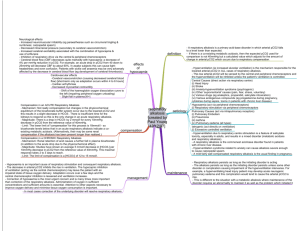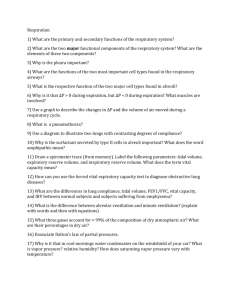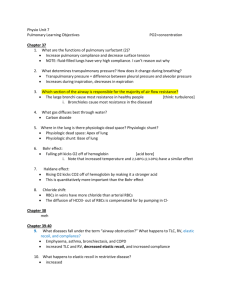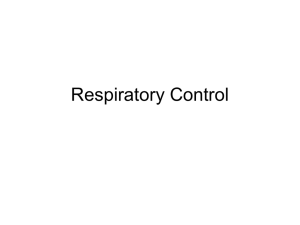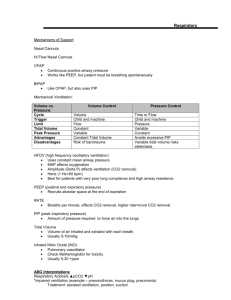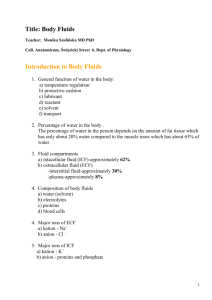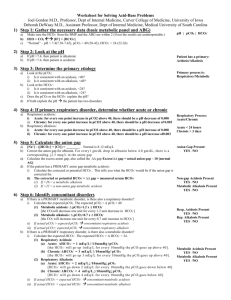Respiratory Alkalosis
advertisement
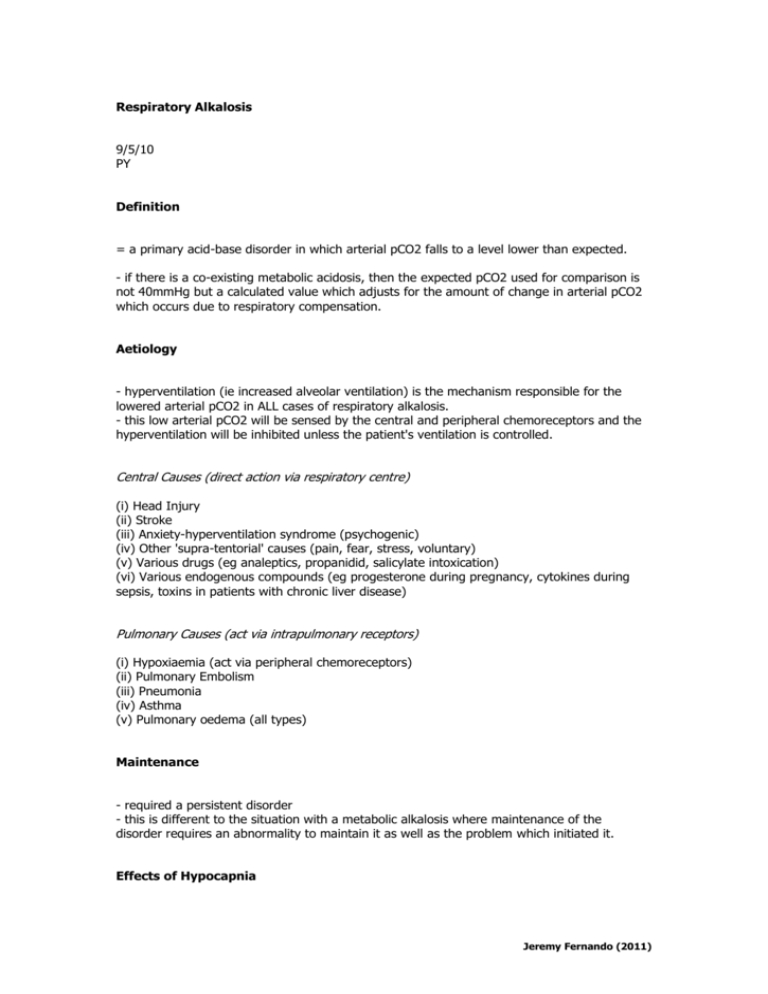
Respiratory Alkalosis 9/5/10 PY Definition = a primary acid-base disorder in which arterial pCO2 falls to a level lower than expected. - if there is a co-existing metabolic acidosis, then the expected pCO2 used for comparison is not 40mmHg but a calculated value which adjusts for the amount of change in arterial pCO2 which occurs due to respiratory compensation. Aetiology - hyperventilation (ie increased alveolar ventilation) is the mechanism responsible for the lowered arterial pCO2 in ALL cases of respiratory alkalosis. - this low arterial pCO2 will be sensed by the central and peripheral chemoreceptors and the hyperventilation will be inhibited unless the patient's ventilation is controlled. Central Causes (direct action via respiratory centre) (i) Head Injury (ii) Stroke (iii) Anxiety-hyperventilation syndrome (psychogenic) (iv) Other 'supra-tentorial' causes (pain, fear, stress, voluntary) (v) Various drugs (eg analeptics, propanidid, salicylate intoxication) (vi) Various endogenous compounds (eg progesterone during pregnancy, cytokines during sepsis, toxins in patients with chronic liver disease) Pulmonary Causes (act via intrapulmonary receptors) (i) Hypoxiaemia (act via peripheral chemoreceptors) (ii) Pulmonary Embolism (iii) Pneumonia (iv) Asthma (v) Pulmonary oedema (all types) Maintenance - required a persistent disorder - this is different to the situation with a metabolic alkalosis where maintenance of the disorder requires an abnormality to maintain it as well as the problem which initiated it. Effects of Hypocapnia Jeremy Fernando (2011) CNS - increased neuromuscular irritability (eg paraesthesias such as circumoral tingling & numbness; carpopedal spasm) - decreased intracranial pressure (secondary to cerebral vasoconstriction) - inhibition of respiratory drive via the central & peripheral chemoreceptors - cerebral blood flow (CBF) decreases quite markedly with hypocapnia - lightheadedness & confusion CVS - cerebral vasoconstriction (causing decreased cerebral blood flow) - cardiac arrhythmias - decreased myocardial contractility - shift of the haemoglobin oxygen dissociation curve to the left (impairing peripheral oxygen unloading) - slight fall in plasma [K+] Compensation Compensation in an ACUTE Respiratory Alkalosis - mechanism: not really compensation but changes in the physicochemical equilibrium of the bicarbonate buffer system occur due to the lowered pCO2 and this results in a slight decrease in HCO3-. - magnitude: drop in HCO3- by 2 mmol/l for every 10mmHg decrease in pCO2 from the reference value of 40mmHg. - limit: the lower limit of 'compensation' for this process is 18mmol/l – so bicarbonate levels below that in an acute respiratory alkalosis indicate a coexisting metabolic acidosis. Compensation in a CHRONIC Respiratory Alkalosis - mechanism: renal retention of acid causes a further fall in plasma bicarbonate. - magnitude: studies have shown an average 5 mmol/l decrease in [HCO3-] per 10mmHg decrease in pCO2 from the reference value of 40mmHg. - limit: the limit of compensation is a [HCO3-] of 12 to 15 mmol/l. Management - hypoxaemia is an important cause of respiratory stimulation and consequent respiratory alkalosis -> give O2 - the decrease in arterial pCO2 inhibits the rise in ventilation -> the hypocapnic inhibition of ventilation (acting via the central chemoreceptors) may leave the patient with an impaired state of tissue oxygen delivery - in most cases correction of the underlying disorder will resolve respiratory alkalosis. Jeremy Fernando (2011)
